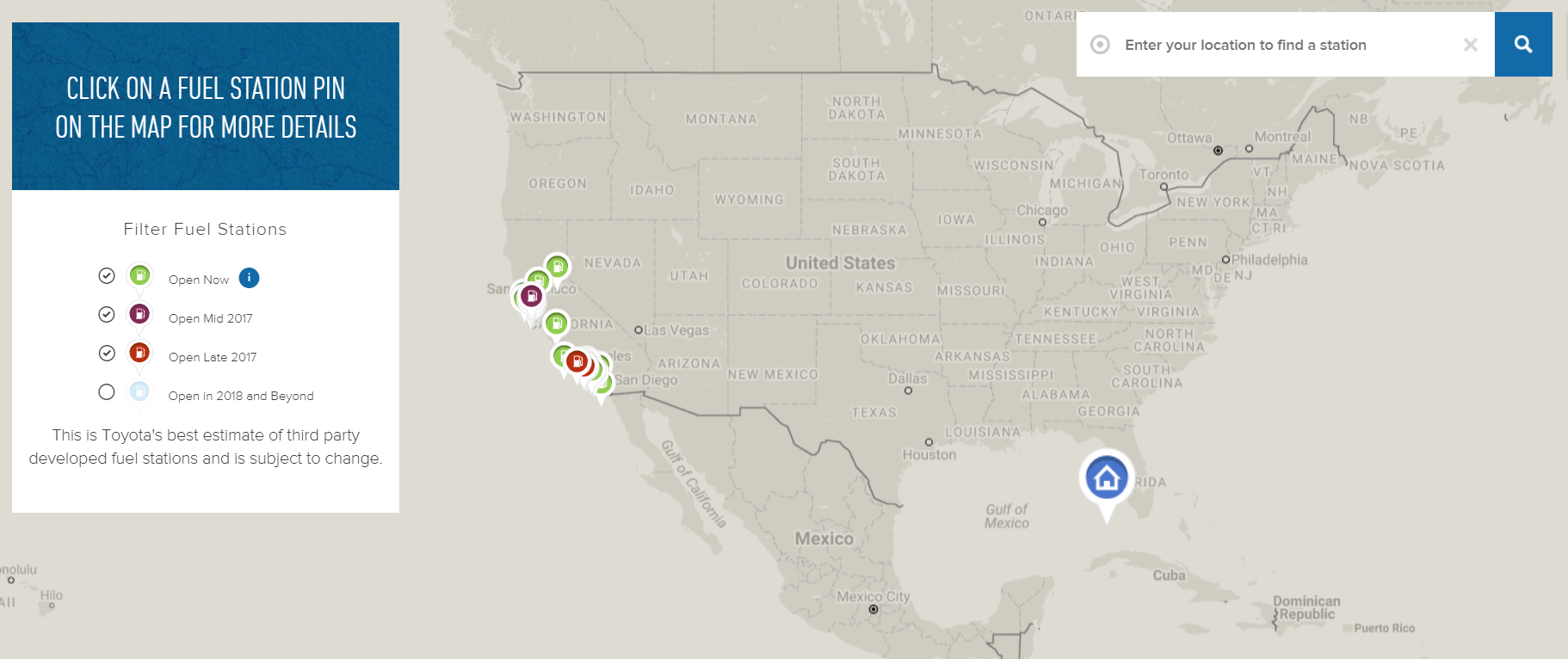The Toyota Mirai is one of the world's first commercially sold hydrogen fuel cell cars. Toyota believes that hydrogen fuel cell cars -- like their Mirai -- are the future of automotive transport; appropriately, the vehicle's name, "Mirai", is Japanese for 'future'. Today's blog will take a deeper look at the Mirai, answer questions such as how much it will cost, how hydrogen fuel cells work, and how Toyota's newest addition to their fleet compares to Drover's favorite car of tomorrow: the Tesla Model S.
Photo Credit: Toyota.com
The Mirai: Overview
While hydrogen fuel cell cars aren't a particularly new idea, the Mirai is Toyota's first commercially released fuel cell car, touting the bold slogan "The Future. Available Now." The 2017 Mirai is offered in six colors -- Red, Blue, Teal, White, Black, and Grey. Current MSRP for Toyota's future machine is $57,500. With that said, there are some rebates and incentives that can help knock that down to closer to $50k -- an expensive price tag for a Toyota nonetheless. The exterior is a sleek, aerodynamic sedan with dramatic cut-outs more reminiscent of the 2017 Lexus fleet than other Toyota sedans. Inside, you've got leather seats, a touch screen media console equipped with apps, state-of-the-art climate control, etc. From the pictures on Toyota's website (included above), the Mirai's design appears to be an incredibly luxurious and modern vehicle that the vast majority of drivers would be proud to own in 2017.
At a glance, some quick Mirai features include 3 year's worth of complimentary hydrogen fuel to new owners, a range of 312 miles per fill-up, an approximate 5 minute refuel from empty, and zero carbon emissions.
Hydrogen Fuel Cells
The Mirai is powered by a hydrogen fuel cell, making it a hydrogen fuel cell car. If you're like me before I wrote this, you probably have no idea what that means. Hydrogen fuel cell cars are essentially electric cars that use a mini onboard hydrogen power plant to generate the electricity instead of drawing it from a battery. Keep in mind that electric vehicles, like Tesla, have two major components -- a huge battery and an electric motor. The electric motor is what physically moves the car, while the huge battery stores and provides electricity for the electric motor to function. Hydrogen fuel cell cars like the Mirai also have electric motors. The only difference is the electricity comes from hydrogen fuel cells.
Hydrogen fuel cells generate electricity as follows. First, you fill your Mirai or other hydrogen fuel cell cars up with hydrogen at a fuelling station (to be discussed later). That hydrogen enters storage tanks in your car. Quick pause. You are probably wondering how safe it is to have tanks filled with pressurized gas inside your car. The short answer is it's just about as safe as having a tank of gasoline in your car. The long answer is 1) I saw a YouTube video where one of Toyota's hydrogen tanks was shot by a pistol. Instead of exploding as you'd expect, the gas simply leaked out of the bullet hole. 2) the amount of Hydrogen that that Mirai holds has about half the explosive power your typical gas tank holds. Returning to the mechanics -- hydrogen enters storage tanks in your car.
Next, the car takes in air from the front grill. Then, the oxygen in the air interacts with the hydrogen to create electricity. When you floor the pedal, electricity is sent to the electric motor in the same way Tesla's motor receives energy from a battery. The only byproduct of creating this electricity onboard your vehicle is pure water which leaves through the Mirai's tailpipe.
The Mirai: Practical or Not?
The vast majority of my blogs have treated electric vehicles, electric rideshare, and explaining how electric vehicle technology -- based on batteries -- is a viable alternative to your standard gas-powered internal combustion engine. The Mirai and other hydrogen fuel cell cars truly are electric vehicles at heart. However, the differentiating factor between the Mirai and the electric vehicles we are most used to (Teslas, etc) is that instead of drawing electricity from a battery, the Mirai creates power on board via a mini electric power plant on board that generates electricity by facilitating a chemical reaction between hydrogen (which you fill the car up with at fueling stations) and oxygen taken in from the outside air.
Hypothetically, hydrogen fuel cell cars like the Mirai could be just as viable if not more practical than electric vehicles like Teslas. I base this assertion on the fact that the Mirai's range is 312 miles -- comparable to the Tesla P100D's 315-mile range. Moreover, from an environmental perspective, the Mirai has zero carbon emissions -- just like Tesla's electrics. A HUGE advantage the Mirai has over Teslas is it's 5 minute refuel time. Even Tesla's supercharging stations take 30 mins to a full 1 hour to recharge Tesla vehicles. While a Tesla roadtrip would require extended breaks every 315 miles, a Mirai roadtrip would hypothetically be as seamless as any taken with a traditional gasoline car -- roughly 5 minutes at the pump. So, to summarize, the Mirai has the potential to be equally efficient and 'green' as Tesla's while also being WAY more roadtrip and time-friendly than Tesla's. A quick note on fuel -- the cost of electricity to recharge a Tesla and the cost of hydrogen to fuel a Mirai is roughly equivalent.
With that said, stated bluntly, the 2017 Mirai has nothing on the 2017 Tesla. I will give you two reasons.
- Speed. The Tesla P100D does 0-60mph in 2.28 secs... literally record-breaking. By contrast, the Mirai does 0-60mph in a staggering, turtle-esque, life-drainingly slow 9.4 secs. Take a guess as to which vehicle I would rather own :/
- Fueling Network. Tesla has made a HUGE effort to create a national network of supercharging stations for their vehicle, making a national road-trip with Tesla completely, 100% possible, as well as making owning a Tesla possible and convenient in the vast majority of the US. By contrast, there are literally 11 hydrogen fueling stations in the country, all of which are in California. 9 of which are in Southern Cali. So, if you live anywhere besides the California Bay Area, you literally cannot own a Mirai right now in 2017 because you'd have nowhere to fuel it.
Tesla's Incredible Network of Public Supercharging Stations
The USA's Public Hydrogen Fuel Pump Stations which the Mirai can use.... OUCH












